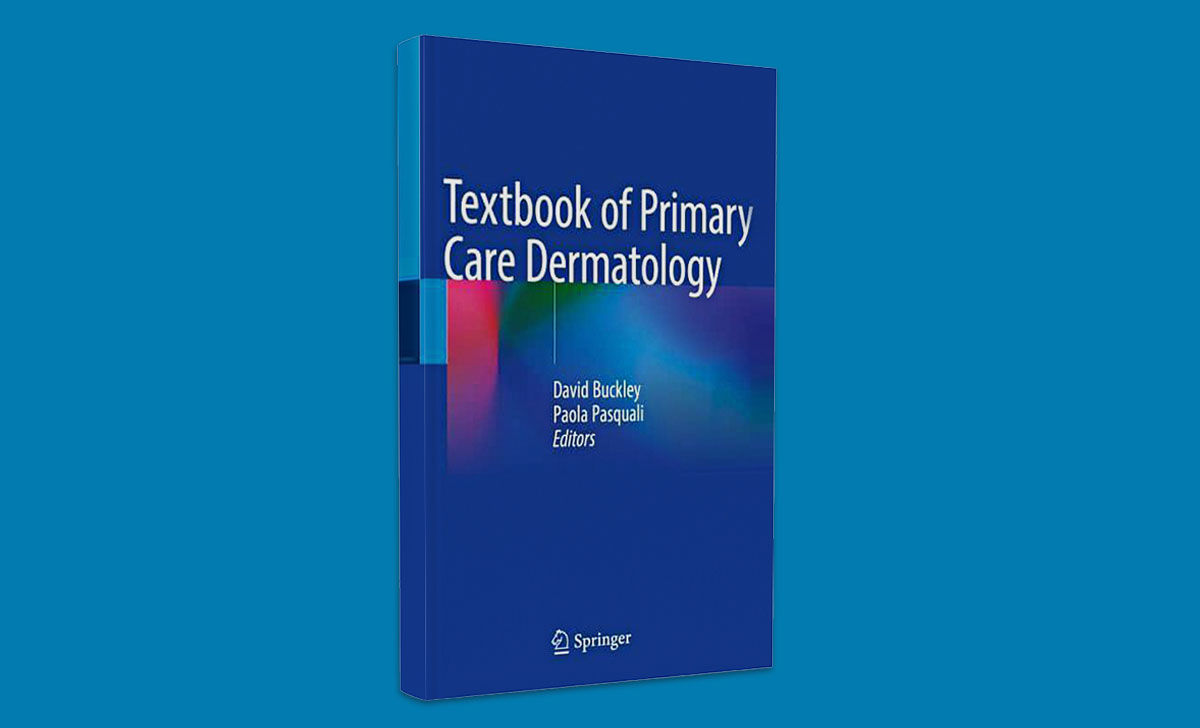| BOOK TITLE: | Textbook of Primary Care Dermatology |
| AUTHORS: | Dr David Buckley and Dr Paola Pasquali |
| PUBLISHER: | Springer |
| REVIEWER: | Dr Karen Enright |

As a GP with more than a little interest in dermatology, this book by the guru of primary care dermatology Dr David Buckley, and Dr Paola Pasquali, was my favourite Christmas present.
Dr Buckley is a leader in Irish community dermatology with the Kerry Skin Clinic, which treats all manner of medical, surgical, and allergic skin disease and is an outstanding example of what can be achieved in primary care with training, expertise and passion.
I cannot recommend this textbook enough. All GPs, general practice nurses and other healthcare professionals with (or without) an interest in dermatology would benefit from having a copy of this book on their shelf.
It is written from the perspective of a GP, focusing on the practical management of common, and some uncommon, skin conditions, what we can safely manage ourselves, and how and when to phone a friend.
I cannot recommend this textbook enough
Skin complaints represent at least 15 per cent of GP consultations, and often times they are an ‘add on’ at the end of the consultation – “oh, while I am here doc, can you check this mole/rash/lump for me”.
As Dr Buckley points out, skin disease should be considered as relevant and prioritised the same way as any other medical complaint and we need to remind ourselves and patients of this, because a life-threatening skin cancer could be missed at a treatable stage.
Dr Buckley makes a great point in the chapter on ageing skin; the burden of skin disease is much higher in the elderly and with life expectancy increasing year on year – based on trends predicted by the Central Statistics Office (CSO) in Ireland – the number of people aged over 65 years is likely to double or even triple over the next 35 years. Therefore, there will be an ever-increasing demand for skin care in the elderly in the community going forward.
Dermatology tends to be a marmite subject among GPs; you either love it or hate it. Undergraduate training is significantly lacking in dermatology and so unless they are lucky enough to get a postgraduate dermatology post, skin disease can be much of a mystery to many GPs.
Dr Buckley makes the reassuring statement that when it comes to undiagnosed skin eruptions, it is much more likely to be an unusual presentation of a common problem than a rarity in the subtext of a dermatology textbook. So a broad knowledge of the basics of medical dermatological presentations with a fundamental plan for each is likely to get the majority of presentations managed.
Skin lesions
When it comes to surgical dermatological presentations of pigmented and non-pigmented skin lesions in Dr Buckley’s words: “There is only one rule when assessing suspicious pigmented (or non-pigmented) lesions – if in doubt cut it out or refer to a colleague with more experience in skin recognition.”
The chapter on lesion recognition is a great resource with a f lowchart from the Primary Care Surgical Association (PCSA) describing management of new or changing lesions.
Dr Buckley’s four-point warning signs for skin cancer ‘new cancers do show’ is a very useful and memorable acronym to alert doctors and patients to lesions that should be viewed with suspicion:
- New – a new growth sore, freckle or mole that has appeared in the past six-to-12 weeks.
- Changing – a growth, sore, freckle or mole that is changing in size, shape or colour.
- Different – a growth, sore, freckle or mole that looks different from any other, ‘ugly duckling’ sign.
- Sore – a growth, sore, freckle or mole that is sore, tender, bleeding or itchy.
Acne
Acne is one of the most common dermatological presentations in general practice, with 90 per cent of teenagers developing it at some stage and around half of these continuing to suffer as an adult. Dr Buckley describes a stepwise approach to management with flow charts, rationale behind each treatment, and what to do if not responding.
Included is a prescribing guide, courtesy of Dr Deirdre Lundy, one of Ireland’s leading experts in women’s health, describing acne as generally mediated through progesterone, which can be a likely side-effect of second-generation oral contraceptive pills (OCP). Therefore, it is recommended to switch to a fourth-generation OCP initially and if not improving increase to a higher oestrogen dose OCP. The examples of each of these with trade names are listed, making this a most useful and practical reference flowchart.
Dr Buckley also describes how to safely treat acne in pregnancy, which can be challenging.
Eczema
Included in the chapter on eczema is something I have never read before; a table listing over-the-counter (OTC) emollients from most oily to least. This is incredibly helpful when suggesting the most appropriate emollient or soap substitute for a patient, when invariably they have already tried a few, and this gives the expertise to explain why their eczema/dermatosis/xerosis has not responded and what might be a better choice.
Allergic skin disease
Included in the allergic skin diseases chapter is a table describing how to distinguish various forms of dermatitis; atopic, irritant contact dermatitis, and allergic contact dermatitis from clinical features. Then most helpfully when and what allergy test is required to confirm the diagnosis; from IgE blood tests, skin patch or skin prick testing – which speaking for myself has always been a subject of confusion. Following is a list of common allergens tested on a patch test (type 4 allergy, eg, allergic contact dermatitis) and aeroallergens and ingested allergens on skin prick testing (type 1 hypersensitivity, eg, urticaria). Although any type of drug can cause any type of dermatological eruption, a list of the most common suspects is provided to give some clarity when trying to eliminate iatrogenic aetiology in those difficult to treat chronic urticaria presentations.
Warts
Warts are a very common and often frustrating presentation in primary care for the doctor and the patient. Although they are harmless (aside from anogenital warts, which are associated with increased risk of cancer) and will inevitably resolve within two years, they can cause distress and embarrassment especially in children and young adults when on the face or hands. A list of treatment options when the first-line OTC topical ointments have not been successful is provided. This includes the obvious cryosurgery, but also the less obvious 5 per cent imiquimod, topical podophyllotoxin, topical glutaraldehyde, and a very effective treatment used in Canada, cantharidin, which may become available in Ireland in the future. Equally practical information is a list of the salicylic acid-based topical treatments with the percentage of salicylic acid present in the preparation from ‘Vericaps plasters’ at 12 per cent to ‘Verrugon ointment’ at 50 per cent, meaning if patients want to stick with topical therapy, an evidence-based suggestion can be given with stepwise increase in concentration of salicylic acid. About 75 per cent of warts will resolve with topical salicylic acid when used properly.
Skin surgery
Now for a subject close to my heart, skin surgery. A strap line for all primary care surgical-trained GPs is, “If in doubt, cut it out.” As Dr Buckley describes, training in dermoscopy can often help with diagnosis of pigmented and non-pigmented skin lesions, but if an accurate diagnosis cannot be made, the safest option is to gain histology with an incisional or excisional skin biopsy. In Dr Buckley’s words, “any changing or new mole over the age of 40 should be viewed with suspicion and referred to a colleague with more experience in skin lesion recognition.” Equally, although most melanomas are pigmented, amelanotic melanomas can present as a non-pigmented macule or nodule and “any new or changing lesion, regardless of colour, should be viewed with suspicion and biopsied unless a confident, clinical, named diagnosis can be made based on history, examination, and dermoscopy”.
Dr Buckley outlines best practice for simple skin surgery with pathways for biopsy and safeguarding tips including: “most skin surgery errors are made with the pen not the knife”. Other tips include stretching the skin perpendicular to Langer lines when doing a punch biopsy to enable easy closure, wound healing, and reduced scar formation.
Something very useful as a quick reference for any GP performing skin surgery is the outline of the PCSA guidelines for patients taking anticoagulants and skin surgery, for patients taking antiplatelets, DOACs or warfarin.
There is also a great tip on local anaesthetic and adrenaline use when performing skin surgery.
Photoageing
The chapter on photoageing was most interesting. Dr Buckley makes an interesting point that most ageing of the face and hands is likely to be due to accumulation of photodamage from UV exposure. Actinic keratosis, solar lentigos, elastosis, skin thinning, wrinkling, telangiectasia, purpura, and of course NMSA all increase with age, but if you compare the skin on the face to that of the buttocks – it is evident there is a vast influence from UVR.
There are various treatments including topical tretinoin, hydroquinone, vitamin C and E, chemical peels, and aesthetic injectables, such as botulinum toxin and intradermal fillers, which can address some of the ageing effects of the skin. However, the most basic and effective is prevention rather than cure by the application daily of SPF factor 30 or greater all year round.
The chapter on vascular tumours and melanocytic naevi in children is very useful
Dr Buckley debunks some of the myths surrounding SPFs. Anything over SPF 50 does not confer any additional benefit and adds an additional chemical load as the higher the SPF in chemical sunscreens, the higher the concentration of sun-filtering chemicals. For this reason physical sunscreens may be more suitable for people with sensitive or allergy prone skin. Chemical sunscreens may be poorly tolerated by patients with rosacea, lupus or photodermatosis. Of course, here in not-so-sunny Ireland the majority of us are vitamin D deficient in the winter months. The use of high-factor SPF may interfere with the skin’s ability to metabolise vitamin D in the summer, therefore Dr Buckley suggests considering a vitamin D supplement, especially in those aged over 50 years.
Leg ulcers
The chapter on leg ulcers gives a really straightforward approach when addressing a leg ulcer. Dr Buckley recommends that basic advice to the patient should not be underestimated, which includes encouraging walking and avoiding standing, elevating the feet and ankles for two hours in the morning and evening, and maintaining a healthy weight, diet, and level of hydration.
In clinic the next practical step is to perform a pedal pulse check and ankle brachial pressure index (ABPI) if these are weak, impalpable or difficult to assess. Based on the ABPI index, the recommendation of grades of compression or referral to a vascular surgeon is described.
He then gives a visual step-by-step demonstration of how to apply compression bandages. And beyond that a description of what type of dressing is suitable for each type of ulcer whether it be infected, complicated/resistant, non-infected exudative or simply weeping eczema. I will admit the world of dressings has always been a mystery to me, leaving that rather sheepishly in the hands of my esteemed nursing colleagues!
Dr Buckley outlines timeframes where ulcers less than 1cm should heal over six-to-12 weeks with compression bandages, with advice on when to change the dressings.
Practical tips
A tip I will most definitely use to aid diagnosis of pityriasis versicolour is to place sellotape over a small plaque. This common patchy scaly hyper- or hypo-pigmented eruption is caused by a proliferation of a normal skin commensal Malassezia. Using the sellotape will reveal an area of scales in the exact shape as the skin lesion. Once treated with oral or topical anti-fungals the infection is no longer present, but the pigmentary changes can persist for six-to-12 weeks.
Vascular tumours and naevi
The chapter on vascular tumours and melanocytic naevi in children is very useful. Dr Buckley describes the different vascular tumours: Capillary haemangioma (strawberry naevus), capillary malformations (port wine stain), and nevus flammeus (stork mark and angel kisses). He describes the clinical features, the natural history and when to refer to dermatology and why. Of interest is the advice to refer infants with over five capillary haemangiomas for a liver ultrasound, because of increased risk of liver haemangiomas. Also, presence of capillary haemangiomas in the midline increases risk of airway haemangiomas.
Melanocytic naevus acquired before the age of two are deemed congenital and over the age of two, acquired. He describes the appearance and histological features of the different types of melanocytic naevus; junctional, compound, and intradermal.
There is also a chapter on Covid-19 skin disease and the merits of telemedicine in dermatology, which is very topical.
A special mention also needs to be given to the patient information leaflets. These are so practical, useful, and time-saving for GPs to have to hand. There is everything from consent forms for minor surgery, hand-care tips for dermatitis, how to safely use topical steroids with fingertip units, to managing scabies and head lice. With Dr Buckley’s permission I will have a copy of all these sitting to hand in my clinic!
I have read my fair share of dermatology textbooks and this is the best, most comprehensive, practical and GP-focused guide I have come across. Thank you Dr Buckley and Dr Pasquali for sharing your wealth of experience and information. The GPs and GPNs who read it, and their dermatology patients, will be all the better for it.
To order a copy of this book go to: https://link.springer.com/book/10.1007/978-3-030-29101-3













Leave a Reply
You must be logged in to post a comment.